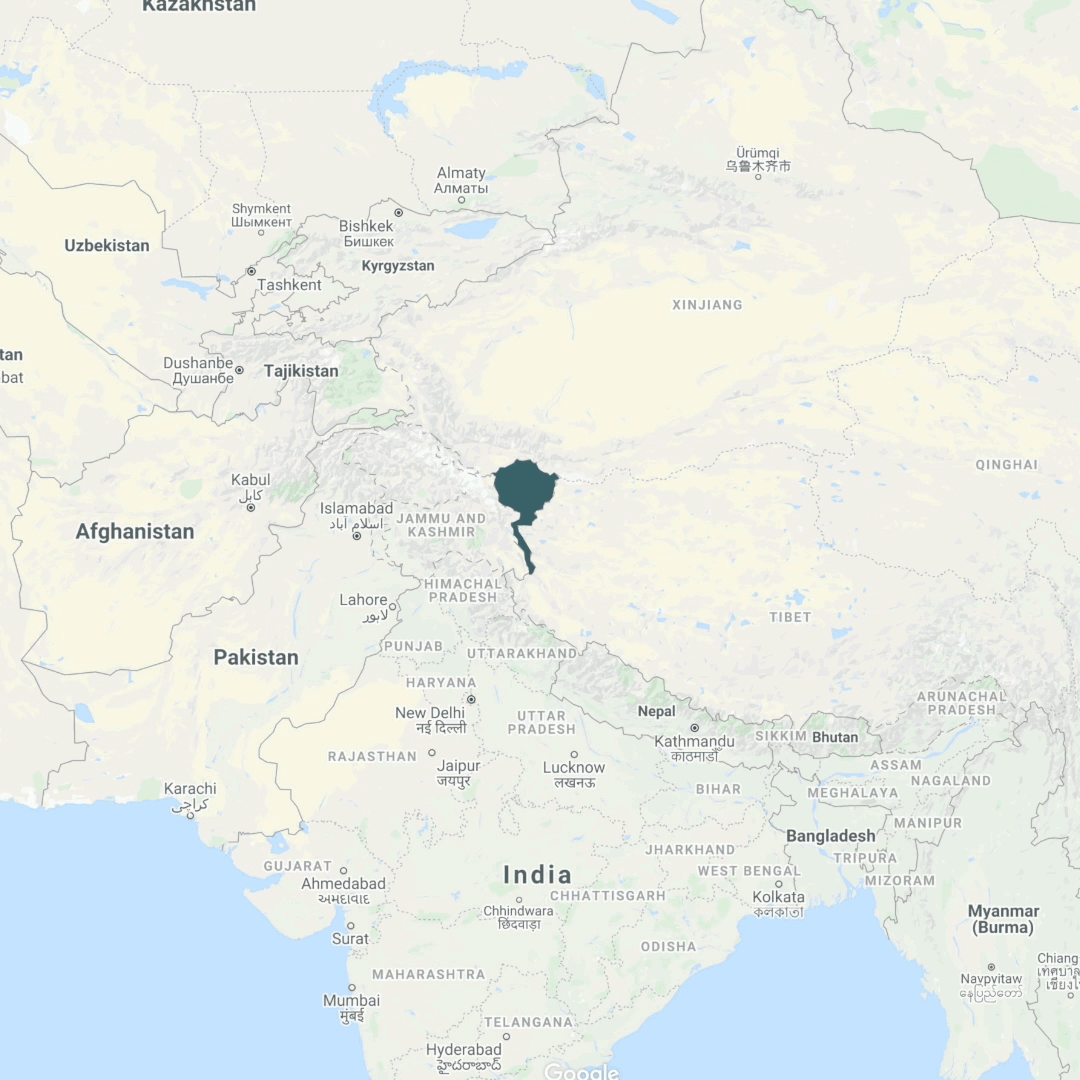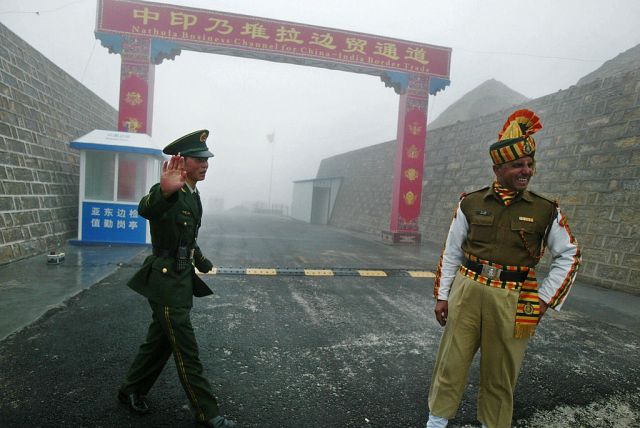Tensions simmer along the 2,100-mile-long border: a Chinese soldier and an Indian soldier stand guard at the Nathu La border crossing. (Photo: DIPTENDU DUTTA/AFP via Getty Images)

When the Dragon and the Elephant dance there’s always the danger that a lot of people could get hurt. The current military and diplomatic tango by the world’s two population giants has brought China and India closer to conflict than at any time in the past 50 years.
The troop movements that triggered the current crisis have been seen before: what’s different now is the construction of facts on the ground which, if left unchallenged, will become permanent and give one side a military advantage in a contested region over which they fought a war in 1962. The region is Aksai Chin. India says that despite it being controlled by China it is part of its Ladakh region; China counts it as part of its Xinjiang province. The flashpoints are along what is called the ‘Line of Actual Control’ — (LAC) as in the points at which Indian military control of Ladakh stops, and Chinese military control of Aksai Chin begins.
This line can be drawn on a map, but up at 17,000 feet above sea level shifting river flows and snow mean they are less clear — especially if you want them to be. New Delhi says that in early May an Indian Army patrol near Ladakh’s Pangong Lake was blocked by hundreds of Chinese soldiers operating across the LAC in contravention of a 1996 agreement to respect it. Punches were thrown, then stones, leading to injuries on both sides, but no shots were fired. The Chinese then set up camp, dug trenches, and began moving heavy equipment into an area the Indians say is up to 2½ miles inside the LAC.
Latest reports suggest that 5,000 soldiers of the People’s Liberation Army are now dug in, heavy artillery has arrived, and barracks are being built both near the lake and in the Galwan valley. In all there are five locations in Ladakh which have seen confrontations. India has responded by moving several thousand re-enforcements up to the Line of Actual Control.
Aksai Chin is not coveted for its beauty, mineral riches, or fertile soil: it’s a barren, mostly uninhabitable, freezing cold high plain, but it has attributes beloved of estate agents – commanding views, good transport links, and location, location, location.

From Beijing’s perspective India has been behaving aggressively, most notably by building roads to help its military crisscross the high mountain. The road which most concerns China is one which follows the LAC for several hundred miles and connects Indian military outposts. They have also built a new road to reach a military airstrip, which was reopened in 2008, and which has recently been upgraded to allow the Indian Air Force to land its Super Hercules (C-13OJ) aircraft thus boosting its ability to move men and equipment to the region at speed. The airstrip, in Daulat Beg Oldie, is often the only way to bring in supplies during the winter months.
So, for each side, more than just national pride is at stake. Both capitals know their long-term strategies, and military capabilities, will be enhanced, downgraded, or return to the status quo, depending on their next moves.
India needs to find a way to persuade China to fold its tents and move a few miles back east. It is trying dialogue, but if that fails the options are to either accept what would be a humiliation, or try and move the Chinese by force. In the 1962 conflict that didn’t go well for India, and although it is now a far stronger power so is China. However, failure to shift the Dragon will leave it west of the LAC and positioned to lay claim on Indian territory, at the minimum, on the Galwan valley. Loss of the Pangong Lake would made the region difficult to defend, and any Chinese move further west could cut the new roads India has built. That in turn would reduce its ability to support troops in the region which leads up to the Karakorum Pass linking China and India. China has yet to park a tank on the lawn — but it has planted several red flags.
The Himalayas are mostly impassable so China’s focus is not usually on India despite them sharing a 2,100-mile-long border. It is more concerned with the South China Sea, but increasingly it takes a 360-degree view of the world. This is partially due to its growing power, but also because technology allows it, and its neighbour, to now operate in the high ground. This makes China increasingly sensitive about Aksai Chin, which connects the restive province of Xinjiang to western Tibet. It is also close enough to the Karakorum Highway for Beijing to pay attention when India does anything to strengthen its military position.
The Highway connects China with its long-term ally Pakistan, and is a part of the China-Pakistan Economic Corridor. It runs from China all the way down to the Pakistan port of Gwadar on the Arabian Sea, and as such is a key component in the Belt and Road Initiative. Part of the Highway is routed through Pakistan-controlled Kashmir, which some of the wilder elements in the Indian Hindu nationalist BJP government have spoken about one day recapturing. That alarms Beijing, which also took a dim view of India’s decision last year to redraw its map by splitting Jammu & Kashmir in two to create Ladakh as a union territory that included Aksai Chin.
China knows that India is probably not in a position to enforce its claim to Aksai Chin, but is not in the mood to allow New Delhi to make any moves which strengthen that position without some response.
Hence we see what appears to be China’s first attempt to alter the Line of Actual Control in Ladakh since the 1960s. It’s unlikely to be a coincidence that this latest flare-up occurred in several locations within days of each other: indeed it follows a pattern of challenging the status quo since President Xi came to power eight years ago. Until now the most serious incident came in 2017 when India and China engaged in a 73-day military stand-off on the Doklam Plateau in the north-eastern Indian state of Sikkim before the Prime Minister, Narendra Modi, and President Xi came to an agreement allowing both sides to save face.
Reaching a similar settlement this time looks to be much more difficult, as China does not appear to be in the mood for compromise. With the world’s attention on the Covid-19 pandemic China has been attending to foreign policy. As well as the Ladakh incidents it has sunk a Vietnamese fishing vessel in the South China Sea, harassed a Malaysian oil drilling rig, sailed an aircraft carrier fleet around Taiwan, and tightened its grip on Hong Kong. As China’s Covid-19 pandemic wound down, and others’ intensified, it looks as if Beijing calculated that countries such as India would be too consumed with dealing with the virus to push back against aggressive moves.
President Trump offered his unsolicited help to mediate on the Ladakh crisis but was given short shrift. Celebrations for the 70th anniversary of diplomatic relations between China and India were the opportunity to find a solution but they came and went with any sign of a breakthrough. However, the anniversary was just before the annual National People’s Congress in Beijing opened, and given that the Congress appeared set on projecting China’s strength to the world the timing was unfortunate. Now that it has finished there may be a new opening.
For that to happen, though, requires a desire for an equitable settlement. Not a shot has been fired across the LAC since 1975. If China feels it can cement the new facts on the ground and maintain that record it will be tempted to reject compromise — and that will leave India will a very hard choice.










Join the discussion
Join like minded readers that support our journalism by becoming a paid subscriber
To join the discussion in the comments, become a paid subscriber.
Join like minded readers that support our journalism, read unlimited articles and enjoy other subscriber-only benefits.
Subscribe